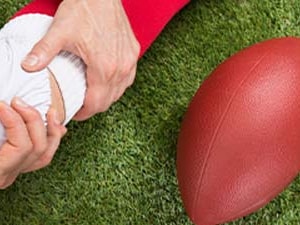Safety First: Exploring the Use of Turf on Athletic Fields
March 15, 2022
5 min. read

Following Odell Beckham Jr.'s non-contact knee injury during the 2022 Super Bowl, the Turf War debate has been triggered once again. The discussion over turf versus grass fields has been ongoing for many years, and as both a Doctor of Physical Therapy who has treated athletes of all ages for the past 25 yearsand a soccer mom of threeI am very familiar with this debate.
Another recent event that spurred discussion over the use of turf was the 2019 Women's World Cup. Turf was a massive point of contention as the players wanted parity with their male soccer counterparts who were allowed to play on grass fields, while the female players were told there wasn't enough money to build equal fields for their games. In this instance, the priority for me is the health and wellness of our athletes of all sexes, ages, and ability levels.
Why Consider Surface Area in Athletics?
As health professionals involved in the treatment and prevention of these injuries, it's essential to understand the differences between grass and turf playing surfaces and how they impact our athletes. We need to know how to mitigate the injury risk factors to the best of our ability.
Regardless of the playing surface, we need to ensure that athletes have full joint range of motion, full muscle flexibility, full muscle strength, endurance, and motor control. These assurances allow for the absorption of impacts, the generation of force and speed, and the ability to withstand collisions with the ball, other athletes, and potentially the playing surface if the athlete falls.
The Pros and Cons of Turf
If turf is so dangerous, why is it used? Here are a few reasons:
Turf fields typically require less time to setup, offer faster installation than traditional grass fields, and require less maintenance.
Turf doesnt require a consistent input of water, which can be a factor in increasingly warmer climates.
Turf is not limited by climate. The accumulation of rain or water from melted snow does not result in turning dirt to mud on turf. I've personally shoveled out a turf soccer field during a late spring snowstorm to allow soccer players to play.
Turf doesnt have to be sprayed and treated with pesticides and other chemicals, as is the case with grass to keep the grass from fostering disease and other pest-related disruptions.
Turf is intended to result in fewer injuries due to cushioned support below artificial turf fields, which traditional grass fields do not offer. Studies have shown that turf fields help soften the impact resulting in fewer injuries for athletes.
However, we know from running related injury research that cushioned shoes and surfaces lessen our body's natural ability to use our joints and muscles to adapt naturally to absorb forces of impact.1
Case Western Reserve University and Sports Medicine Institute at the University of Houston analyzed data collected by 26 high school athletic trainers during the 2017-2018 athletic seasons and found athletes were 58 percent more likely to sustain an injury during athletic activity on artificial turf. Injury rates were significantly higher for football, girls and boys soccer, and rugby athletes. Lower extremity, upper extremity, and torso injuries were also associated with a higher incidence on artificial turf.2
A systematic review published last year evaluated the risk of ACL Injuries and found a 45 percent increase in turf fields. We also see an increased risk of other injuries such as turf toe, head injuries, skin abrasions, foot and ankle injuries, and fractures.3
The Case for Grass Fields
There are many benefits to playing on well-maintained natural grass fields. Some benefits include:
Grass is a natural surface that allows for better impact absorption.
Cleats grab onto grasswith greater ease, providing additional traction when the surface is soft or slippery.
There is less risk of skin injury on grass. Grass eliminates the occurrence of nasty turf burns and open skin wounds, which are always a portal for infection to enter the body. Additionally, healed skin is never as mobile and healthy as what we were born with.
Grass fosters a slower and more controlled game pace due to natural bumps and slower ball speed. This allows athletes to use more movement variability and gain more variable proprioceptive input. It also means the bodies in motion are slower and in greater control, decreasing the frequency and severity of contact impacts.
Grass maintains a natural ambient temperature. Turf temperature runs much hotter. I have stood on a field that radiated heat at 120 degrees!
Grass tends to improve athletic performance, as athletes feel more comfortable and safe playing on a natural surface. Mindset and beliefs do matter!
Grass does not prevent all injuries. Natural ground has more bumps, divots, and holes, which can lead to ankle sprains, knee injuries, and more. While neither grass nor turf are perfect, turf has created new opportunities for additional injuries due to the synthetic nature.
There are many multidimensional factors to be considered in this debate. As a health care practitioner and a proponent for wellness, well-being, and prevention of injury, I am always in favor of what is most safe for our athletes.
To learn more about the role of other environmental factors in our athletes' safety, Medbridge instructor Katie Whetstones course Environmental Considerations for the Athlete explores the prevention and treatment of common weather-related injuries, such as heat illness, hypothermia, dehydration, and altitude sickness, as well as for lightning safety during outdoor events.
Want to view more athletic training courses? Medbridge offers over 600 AT courses spanning specialties and settings. Our courses feature hands-on demonstrations that include real athletes and up-to-date, evidence-based strategies you can apply today.
Below, watch Katie Whetstone discuss lightning safety in sports in this short clip from her MedBridge course "Environmental Considerations for the Athlete."






